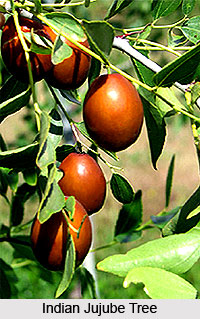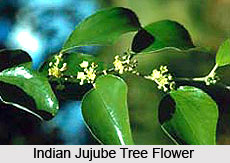 The `Indian Jujube Tree` is nice and beautiful tree that is of small or medium height, but occasionally can reach the maximum height of 24 m. The tree is named as `Ziziphus Iuiuba` in science. The family name of this tree is `Rhamnaceae`. The `Ziziphus` group to which the tree belongs to has a lot of varieties and hence very difficult to give a particular description. It has varieties depending upon not only in the size but in the colour of the leaf and in the size and shape of the fruit also. The tree is known as `Ber` in Hindi and in Bengali, it is called as `Borui`, `Kulgachh` and `Bogri`. It is named as `Ellandi` and `Ilantai` in both the languages of Tamil and Malayalam. In Telugu, the name of this tree is `Rengha`.
The `Indian Jujube Tree` is nice and beautiful tree that is of small or medium height, but occasionally can reach the maximum height of 24 m. The tree is named as `Ziziphus Iuiuba` in science. The family name of this tree is `Rhamnaceae`. The `Ziziphus` group to which the tree belongs to has a lot of varieties and hence very difficult to give a particular description. It has varieties depending upon not only in the size but in the colour of the leaf and in the size and shape of the fruit also. The tree is known as `Ber` in Hindi and in Bengali, it is called as `Borui`, `Kulgachh` and `Bogri`. It is named as `Ellandi` and `Ilantai` in both the languages of Tamil and Malayalam. In Telugu, the name of this tree is `Rengha`.
The bark of the tree is solid and very dark grey in colour. It has some uneven cracks. In the mature all of the branches of the Indian Jujube Tree sweep elegantly downwards and as the tree can be said almost evergreen, the tree remains always attractive. The leaves are minute and scattered and they do not form a very close crown. As a result the tree is unfit to be used as a shade. At the base of the leaf stalks, particularly on the flower branches, two short spines usually appear. Amongst them, one is straight and the other is curved. You may not find them sometimes in the cultivated trees. The leaves of this tree are normally from 2.5 to 7.5 cm in length and oval in shape. They also contain three long veins that run from the base. Their colour is darkish green on the topside and underneath; they are yellowish-brown, off-white, cream or silvery white in colour. They are similar to suede to the touch. Particularly on cultivated trees, the underside of the leaf is pale green in colour occasionally. They can establish their identity without much doubt with the distinctive vein pattern and the way the leaves grow alternately from zigzag twigs.
The flowers of the tree are very tiny and they cluster on slim stems round the leaf stalk. Five triangular petals open from the small, circular buds of the `Indian Jujube Tree` and form a large number of pale green stars. The stamens are the same number as the petals in most of the flowers and they grow beside the middle of each petal. In some varieties of the tree, there are some very long flowering branches each containing several side branches and a large number of clustered florets. The flowers appear around the month of April. At first they appear on some of the trees and according to some people, they bear a most offensive odour at that period. The egg-shaped fruits follow them. The skin of the fruits is thin but tough and the fruits contain a dryish pulp.
 The fruits of the tree are safe to eat and people use the pulp in seasoning food or eat after cooking with sugar. The kernel of the tree is eaten raw. People also preserve the entire acid fruits in oil or in sugar syrup. The wild fruits are green in colour and round shaped in the immature period. When they are ripe, they are frequently used for making sherbet and are commonly sold in the market. This is a favourite to all the students of India. The cultured fruit of the `Indian Jujube Tree` is more oval in shape and like a plum. The people eat the kernels of these fruits, too. A floury meal can be prepared from the dried, ripe fruit and it can be proved very useful in times of scarcity.
The fruits of the tree are safe to eat and people use the pulp in seasoning food or eat after cooking with sugar. The kernel of the tree is eaten raw. People also preserve the entire acid fruits in oil or in sugar syrup. The wild fruits are green in colour and round shaped in the immature period. When they are ripe, they are frequently used for making sherbet and are commonly sold in the market. This is a favourite to all the students of India. The cultured fruit of the `Indian Jujube Tree` is more oval in shape and like a plum. The people eat the kernels of these fruits, too. A floury meal can be prepared from the dried, ripe fruit and it can be proved very useful in times of scarcity.
The `Indian Jujube Tree` is an important tree in the dry regions. It can grow voluntarily and rapidly on poor ground. The tree provides good timber and excellent fuel. It is considered as a very good material for fencing as well. Its branches have the ability to be used as fodder for camels and goats and fruit for man. People employ the bark for tanning. Many parts of the tree also have some medicinal uses and the plant is one of those trees on which the `Eri` and `Tasar` silkworms feed. It is one of the best trees in Punjab for the insects named `Lac`. The insects live on the tender branches of certain trees, suck the juice and form crusts continuously. The crusts are of an orange-red, pitchy substance. Though the insects occur naturally, people do cultivate them extensively as they posse the value of secretion. `Lac` was used for dyes in the early days but since the discovery of aniline dyes it has been of much less value. If purified, the `Lac` becomes shellac that can be used for making sealing wax and varnishes. It can also be used for gramophone records, polishes, lithographic inks and fine lacquer works.











